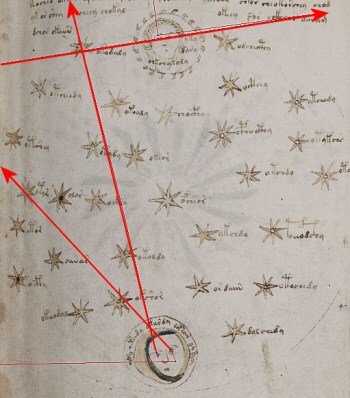f68r LEFT
The image on the left of the f68r fold-out shows what is
possibly the sun over the moon, and stars. Again, there are no geometric markers
on the page but the eyes of the sun and moon have been used as markers. The sun
appears to look in a single direction and the moon in two. If the same pattern
is applied on a star map on the day the supernova is said to have been recorded,
the 4th July 1054 at the time the sun is above the moon and in relation to the
supernova rise/set times, this would place it around 4.40 PM local time at the
point when the supernova is setting on the first day. At this time the sky is
bright and only the sun and supernova would be visible as the moon has set. I
propose the appearance of the moon on this page being different from the other
moon faces is that it represents asset moon below the horizon. Some stars are
shown of what would probably be found in the general area and as some things are
below the horizon it would show calculated positions rather than observed
positions, but the image is a general setting of the scene. Although one would
not expect any correspondence to be accurate it does reflect the same overall
pattern of the image eye markers. The horizontal marker running through the sun
would also run through Procyon and this triangle of Moon, Sun and Alkaid or Ursa
Major may have been used to calculate the position of SN 1572 in Cassiopeia, for
comparison to SN 1054. If the true sky colour is turned off and the brightest
stars shown. This becomes more apparent. The North Pole, the centre of the
Chinese sky map, is also directly over Cassiopeia at this time. This assumes
that the actual position of the Sun in the image has been displaced for the sake
of symmetry on the folio.
 |
 |
| f68r, left, Voynich Manuscript. Credit: Beinecke Rare Book and Manuscript
Library, Yale University. Overlay by P. Han showing eye
markers. |
Credit: Redshift6.
North Pole centred star map (true sky colour), 4/7/1054 AD, North
China. Overlay by P. Han showing comparison of folio eye
markers to positions of the Sun and the Moon, SN 1054, SN 1572. |
Another view of the star map without true sky colour
showing more clearly the actual positions of major stars and the planets.
 |
|
Credit: Redshift6.
North Pole centred star map (not true sky colour),
4/7/1054 AD, North China. Overlay by P. Han showing comparison
of folio eye markers to positions of the Sun and the Moon, SN 1054,
SN 1572. |

Copyright © 2010 P. Han


